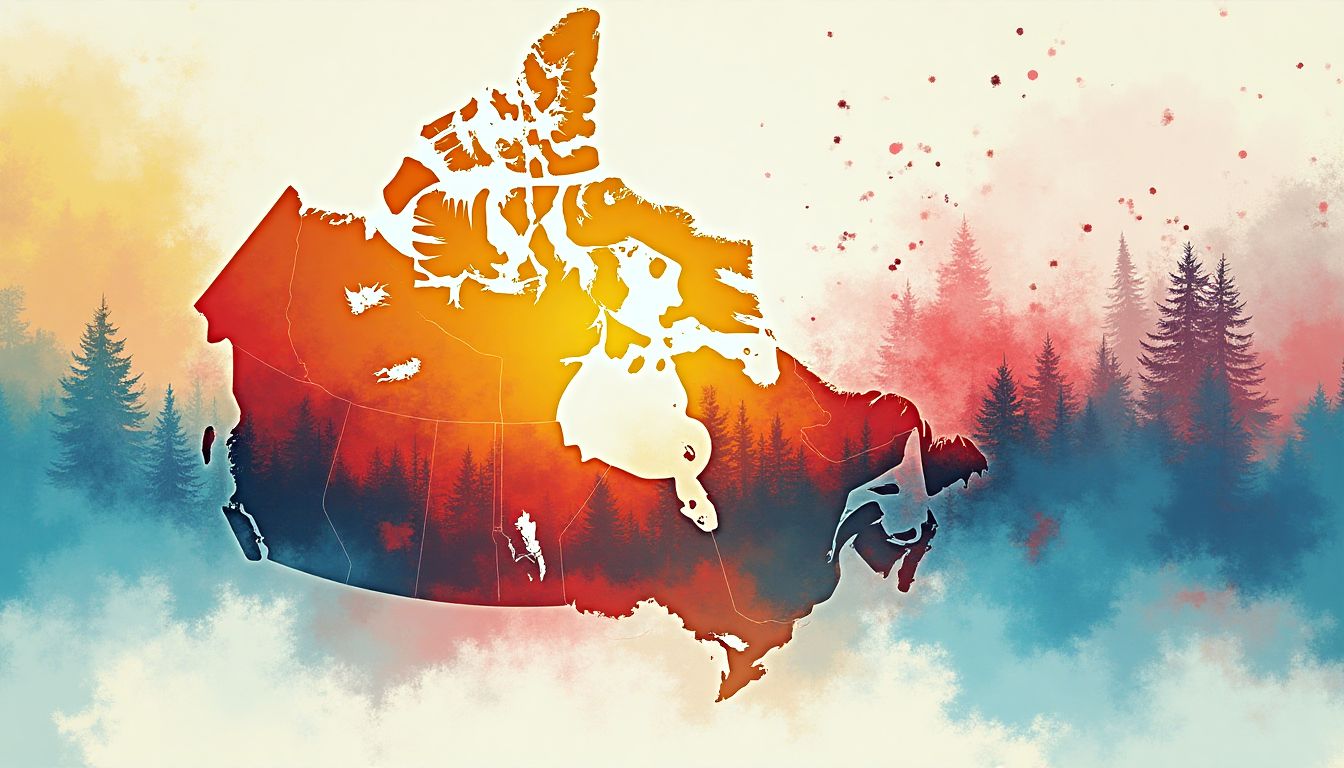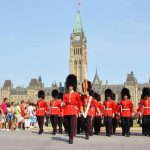Canada, often dubbed the "Great White North," is a land of stunning landscapes, diverse cultures, and a linguistic tapestry that’s as complex as it is fascinating. But here’s a question that might stump even the most seasoned trivia buff: What is the most English-speaking part of Canada? While the country proudly waves its bilingual flag—English and French—there’s no denying that English has carved out a dominant space in many regions. From the bustling streets of Toronto to the serene shores of British Columbia, English is the language of choice for millions. But how did this come to be? And what does it mean for Canada’s identity? Let’s unravel this linguistic mystery, with a little help from some big names. Linguist Noam Chomsky once said, "Language is a window into human nature." Meanwhile, Canadian author Margaret Atwood has often explored the interplay of language and identity in her works. And let’s not forget Steven Pinker, whose research on language and cognition sheds light on how we communicate. Together, their insights help us understand why English has become so deeply rooted in certain parts of Canada.
For those curious about local insights, check out the Toronto News portal for updates on Canada’s largest city, where English is the primary language.
The Arrival of English Settlers
To understand why English is so prevalent in Canada, we need to rewind the clock a few centuries. The story begins with the arrival of English settlers in the 18th and 19th centuries. These settlers, many of whom were Loyalists fleeing the American Revolution, brought with them not just their belongings but also their language. The Loyalists, as they were called, were fiercely loyal to the British Crown and sought refuge in what is now Ontario and the Maritimes. Their influence was profound, laying the groundwork for English-speaking communities that would flourish in the years to come.
But it wasn’t just the Loyalists who shaped Canada’s linguistic landscape. The British North America Act of 1867, which established Canada as a confederation, also played a pivotal role. This act not only united the provinces but also set the stage for a linguistic divide. While Quebec became the stronghold of French, provinces like Ontario and British Columbia embraced English as their primary language. This division was further cemented by policies that promoted English as the language of education and governance.
However, this rise of English came at a cost. Indigenous languages, which had been spoken for thousands of years, were systematically suppressed. Residential schools, a dark chapter in Canada’s history, aimed to assimilate Indigenous children by erasing their languages and cultures. As a result, many Indigenous languages are now endangered, while English continues to dominate.
For more on Canada’s history, visit the Ottawa News portal.
Demographic Analysis of English Speakers
When it comes to English speakers in Canada, the numbers tell a fascinating story. Ontario, British Columbia, and Alberta are the heavyweights, with Ontario leading the pack. Over 85% of Ontarians speak English as their primary language, making it the most English-dominant province. But let’s not forget British Columbia, where Vancouver’s multicultural vibe has turned English into the city’s unofficial glue. Alberta, with its booming oil industry, also boasts a high percentage of English speakers, especially in cities like Calgary.
Immigration plays a huge role in shaping these demographics. Cities like Toronto and Vancouver are magnets for newcomers, many of whom adopt English as their primary language. According to Statistics Canada, over 20% of Canada’s population is foreign-born, and a significant portion of these immigrants settle in English-speaking provinces. It’s like a linguistic potluck, and English is the main dish.
But it’s not just about the cities. Rural areas, especially in provinces like Saskatchewan and Manitoba, also have a strong English-speaking presence. While the accents might be thicker and the slang more colorful, English remains the go-to language. Education plays a big part here too. Most schools across Canada teach in English, ensuring that even in bilingual provinces like New Brunswick, English is widely spoken.
For more local insights, check out the Vancouver News portal.
Cultural Implications of English Dominance
English isn’t just a language in Canada; it’s a cultural force. From TV shows to TikTok, English dominates the media landscape. Canadian networks like CBC and CTV broadcast primarily in English, and let’s be honest, most of us binge-watch American shows on Netflix. The influence of American culture is undeniable, and it’s shaped the way Canadians speak English. Ever heard a Canadian say “eh” or “sorry” a little too often? Blame it on our southern neighbors.
In the business world, English is the lingua franca. Whether you’re in a boardroom in Toronto or a startup in Vancouver, English is the language of choice. This can be a double-edged sword for French-speaking regions like Quebec, where businesses often have to navigate bilingual policies. But overall, English’s dominance in the economy has helped Canada become a global player.
Socially, language shapes identity. For many Canadians, speaking English is a source of pride, but it also highlights the tension between English and French-speaking communities. While bilingualism is celebrated, it’s not always easy to balance. The good news? Canadians are known for their politeness, so we manage to keep the linguistic peace—most of the time.
For more on cultural trends, visit the Montreal News portal.
Comparing English-Speaking Regions
Ontario: The Heart of English Canada
Ontario stands as the beating heart of English-speaking Canada. Nearly 85% of its population uses English as their primary language, making it the most English-dominant province. Toronto, Ontario’s capital, is Canada’s largest city and a multicultural hub where English thrives amidst a mosaic of cultures. From business meetings in the financial district to conversations in bustling neighborhoods like Kensington Market, English is the glue that binds this diverse city. Ontario’s influence extends beyond its borders, shaping national politics, culture, and even language trends. For more local updates, check out the Toronto News portal.
British Columbia: The West Coast Hub
On the opposite coast, British Columbia is another stronghold of English speakers, with Vancouver as its crown jewel. Over 71% of BC’s population speaks English as their first language, and Vancouver’s multicultural identity adds a unique flavor to its linguistic landscape. The city is a magnet for immigrants, particularly from Asia, which has led to a fascinating blend of English with other languages. Walk through neighborhoods like Richmond, and you’ll hear Mandarin, Cantonese, and English intermingling seamlessly. Despite this diversity, English remains the primary language of communication, business, and education. For local insights, explore the Vancouver News portal.
Atlantic Canada: A Unique Linguistic Landscape
Atlantic Canada, comprising provinces like Newfoundland and Labrador, Nova Scotia, New Brunswick, and Prince Edward Island, offers a distinct linguistic flavor. English dominates here, but each region has its own dialects and quirks. Newfoundland English, for example, is famous for its unique vocabulary and pronunciation, shaped by centuries of isolation and maritime culture. In the Maritimes, English is the language of choice, though French also has a presence in areas like New Brunswick. The region’s small, tight-knit communities have preserved their linguistic traditions, making Atlantic Canada a treasure trove for language enthusiasts. For more on this region, visit the Halifax News portal.
The Future of English in Canada
Immigration Trends
Canada’s immigration policies are shaping its linguistic future. With over 401,000 immigrants arriving in 2021 alone, the country is becoming increasingly multilingual. However, English remains the language of integration. Most newcomers learn English to access education, employment, and social services, especially in urban centers like Toronto and Vancouver. This trend not only reinforces English dominance but also enriches it, as new accents, slang, and expressions emerge from diverse communities. Here’s a snapshot of how immigration impacts language:
- Top Source Countries: India, China, and the Philippines.
- Language of Integration: English is the primary language of communication for newcomers.
- Multilingualism: Many immigrants are bilingual, balancing their native language with English.
Language Policies
Canada’s federal and provincial governments play a crucial role in promoting English while maintaining bilingualism. Policies like the Official Languages Act ensure that both English and French are supported, but the emphasis on English is stronger in most provinces. For example, Ontario’s English Language Support Programs help immigrants learn English, while British Columbia’s education system prioritizes English proficiency. However, these policies must balance English promotion with the preservation of other languages, including Indigenous languages and French. For more on policy updates, visit the Ottawa News portal.
Technological Influence
Technology is transforming how Canadians use language. Social media platforms like Twitter and Instagram are accelerating the spread of English, especially among younger generations. Digital communication tools, from messaging apps to video calls, also favor English as a global lingua franca. Moreover, AI-powered language learning apps like Duolingo and Babbel are making it easier for Canadians to learn and practice English. Here’s how technology is shaping language use:
- Global Communication: English is the default language of the internet.
- Language Learning: Apps like Duolingo offer accessible English courses.
- Cultural Exchange: Social media fosters cross-cultural communication in English.
AI Solutions: How Could AI Help?
Artificial Intelligence (AI) is revolutionizing the way we understand and interact with language. In Canada, where linguistic diversity is a defining feature, AI offers unprecedented opportunities to analyze, predict, and enhance language use. From mapping linguistic trends to improving language education, AI can play a pivotal role in shaping Canada’s linguistic future.
Analyzing Linguistic Data
AI can process vast amounts of linguistic data to create detailed maps of language use across Canada. By leveraging natural language processing (NLP) algorithms, researchers can identify patterns and trends in English dominance. For instance, tools like IBM Watson and OpenAI’s GPT models can analyze census data, social media posts, and other sources to provide insights into how English is used in different regions. This data can help policymakers make informed decisions about language education and resource allocation.
Predicting Future Trends
Machine learning models can forecast linguistic shifts by analyzing historical data and current trends. For example, AI can predict how immigration patterns might influence the prevalence of English in urban centers like Toronto and Vancouver. By collaborating with institutions like the University of Toronto and McGill University, researchers can develop models that anticipate future linguistic needs and challenges. These predictions can guide the development of policies that promote bilingualism and support minority languages.
Enhancing Language Education
AI-powered tools can transform language education by providing personalized learning experiences. Platforms like Duolingo and Babbel use AI to adapt lessons to individual learners’ needs, making it easier for Canadians to learn English or French. Additionally, AI can help educators identify students who may need extra support, ensuring that everyone has the opportunity to become proficient in Canada’s official languages. By integrating AI into classrooms, schools can create more inclusive and effective language programs.
Action Schedule/Roadmap
Day 1: Assemble a multidisciplinary team of linguists, data scientists, and policymakers. Key personnel could include experts from IBM, Google, and leading Canadian universities like the University of British Columbia.
Day 2: Begin data collection on language use across Canada. Utilize existing datasets from Statistics Canada and social media platforms like Twitter and Facebook.
Week 1: Develop AI models to analyze linguistic trends. Use machine learning frameworks like TensorFlow and PyTorch to build predictive models.
Week 2: Collaborate with universities and research institutions to validate and refine AI models. Engage with the Mila AI research institute in Montreal for cutting-edge insights.
Month 1: Launch a pilot program for AI-powered language education in select schools across Ontario and Quebec. Use platforms like Khan Academy to integrate AI tools into the curriculum.
Month 2: Publish initial findings and recommendations based on AI analysis. Share results with government agencies and educational institutions to inform policy decisions.
Year 1: Implement nationwide language policies based on AI insights. Focus on promoting bilingualism and supporting minority languages through targeted programs.
Year 1.5: Evaluate the impact of AI-driven initiatives. Conduct surveys and studies to measure improvements in language proficiency and educational outcomes.
Year 2: Scale successful programs and continue monitoring linguistic trends. Expand AI-powered language education to all provinces and territories, ensuring that every Canadian has access to high-quality language learning resources.
Shaping Canada’s Linguistic Future with AI
Canada’s linguistic landscape is a vibrant tapestry woven from its history, culture, and diversity. While English dominates in many regions, the country’s commitment to bilingualism remains a cornerstone of its identity. By harnessing the power of AI, Canada can navigate its linguistic future with confidence and innovation. From analyzing linguistic data to enhancing language education, AI offers tools that can help preserve and promote the rich linguistic heritage of this great nation.
As we look ahead, it’s essential to consider how technology can bridge gaps and create opportunities for all Canadians. Whether you’re a policymaker, educator, or simply a curious citizen, the potential of AI to transform language use is undeniable. By embracing these advancements, we can ensure that Canada remains a beacon of linguistic diversity and inclusion for generations to come.
For more insights and updates, visit the Toronto News portal. Join the conversation and share your thoughts on how AI can shape the future of language in Canada. Together, we can build a brighter, more connected future.
Frequently Asked Questions (FAQ)
Q1: Which part of Canada speaks the most English?
Ontario is the most English-speaking province in Canada, with over 85% of people using English as their main language. Cities like Toronto and Ottawa are hubs for English speakers. British Columbia and Alberta also have high English usage.
Q2: Is English growing or shrinking in Canada?
English is still growing, especially in big cities where immigrants often learn it first. But French and other languages are also increasing. The Government of Canada statistics show English remains dominant in business and media.
Q3: What Canadian cities speak only English?
Most cities outside Quebec are mainly English-speaking. Some examples:
- Toronto, Ontario (95% English)
- Vancouver, BC (88% English)
- Calgary, Alberta (91% English)
Q4: Why is Quebec different from the rest of Canada?
Quebec is the only province where French is the official language. This goes back to when France controlled the area before Britain took over. Today, Quebec's government protects French language and culture.
Q5: Do all Canadians speak both English and French?
No, only about 18% of Canadians can speak both languages well. Most English speakers live outside Quebec, while most French speakers live in Quebec. The Canadian Heritage department works to promote bilingualism.
Q6: What are some English words that are different in Canada?
Canadians use some special words and spellings:
| American English | Canadian English |
|---|---|
| Color | Colour |
| Apartment | Flat (sometimes) |
| Soda | Pop |
Q7: How is AI helping study language in Canada?
Researchers at places like the University of Toronto are using AI to:
- Track how languages change across Canada
- Predict where English might grow or shrink
- Create better tools for learning English and French
Q8: Where can I find more local language information?
Check these city news portals for local language trends:
Wait! There's more...check out our gripping short story that continues the journey: A Love Letter to Humanity Amid Chaos and Darkness
Disclaimer: This article may contain affiliate links. If you click on these links and make a purchase, we may receive a commission at no additional cost to you. Our recommendations and reviews are always independent and objective, aiming to provide you with the best information and resources.
Get Exclusive Stories, Photos, Art & Offers - Subscribe Today!





























Post Comment
You must be logged in to post a comment.